
Have you ever set sail on a project only to find yourself in uncharted waters, surrounded by the fog of uncertainty? The journey can be both exhilarating and daunting in citizen development, where individuals of diverse technical backgrounds shape their own applications. How can you navigate the turbulent seas of project risks and requirements in citizen development and emerge victorious? Fear not, for in this blog, we will be your guiding light, revealing the secrets to charting a successful course in citizen development. From engaging stakeholders to mastering risk management and from effective communication to the art of crystal-clear requirements, we invite you to join us on this voyage toward citizen development excellence.
Before we dive into the specifics, it’s crucial to understand the core concepts of project risks and requirements. We’ll explore what they mean in the context of citizen development and why they’re so essential.
In any project, the key to success lies in how well we anticipate and navigate potential risks and in having a crystal-clear understanding of what is required. For citizen development projects, managing risks effectively and defining requirements precisely play pivotal roles in determining the project’s outcome. They are like a roadmap guiding the project through uncertainties and ensuring that the end result meets expectations.
Project Risks in Citizen Development
Citizen development initiatives offer great potential for innovation and agility within organizations. However, these projects have certain inherent risks that need careful consideration to ensure their success.
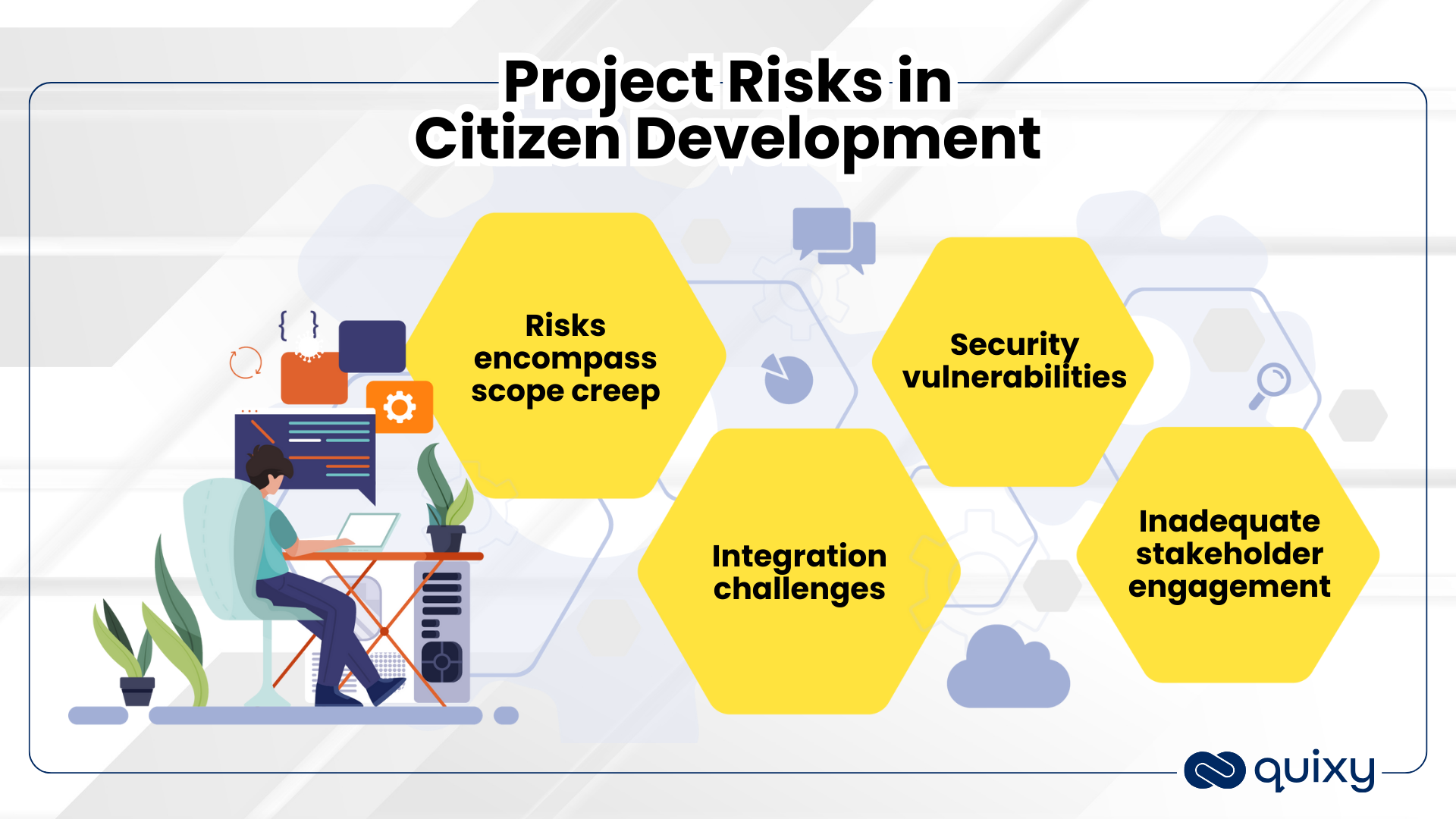
Impact of Project Risks:
- Scope Creep Impact:
- Delays, increased costs, and potential diversion from the project’s core objectives.
- Integration Challenges Impact:
- Data inconsistencies, operational disruptions, and compatibility issues within systems.
- Security Vulnerabilities Impact:
- Compromised data, damaged reputation, financial losses, and legal implications in case of breaches.
- Inadequate Stakeholder Engagement Impact:
- Solutions not meeting user needs, resulting in dissatisfaction and low adoption rates.
Understanding and mitigating these risks is essential to maximize the benefits of citizen development while ensuring smooth project execution and alignment with organizational goals.
Before embarking on a citizen development project journey, it’s essential to establish its fundamental aims and boundaries with the help of a value tree. This involves clearly defining the project’s existence and what it aims to accomplish. By establishing this groundwork, we create a framework that enables us to address risks better and fulfill requirements efficiently. This clarity is a guiding light throughout the project, ensuring alignment with objectives and successful delivery.
Masterful Strategies for Keeping Projects on Track
One of the most effective strategies to keep risks in check throughout a project is prioritizing the discussion around Stakeholder Classification. This particular aspect plays a pivotal role in the overall success of any initiative. It involves the identification and comprehensive understanding of the various stakeholders involved.
These groups encapsulate Business stakeholders, responsible for aligning projects with overarching objectives; Enterprise stakeholders, influencing the project’s strategic direction and scalability; and Environmental stakeholders, encompassing the broader community impacted by the project.
Stakeholder Requirements in Application Development
Understanding the intricate roles and influence of each stakeholder category is pivotal. It enables project managers to manage expectations adeptly, cater to diverse requirements, and foster collaborative environments conducive to successful citizen development initiatives.
| Business Stakeholders | Enterprise Stakeholders | Environmental Stakeholders |
|---|---|---|
| – Directly impacted by project outcomes within the organization | – Represent external entities or the wider community impacted by the project | – Represent external entities or wider community impacted by the project |
| – Concerned with alignment to business goals and strategies | – Responsible for alignment with long-term enterprise strategies | – Concerned with social, ethical, and environmental implications |
| – Include internal teams, managers, or departments affected | – Focus on the project’s broader implications across the organization | – Includes customers, local communities, regulatory bodies, or advocacy groups |
| – Define project success criteria | – Scalability, adherence to policies, influence span multiple projects and business units | – Influence project decisions and public perceptions based on social, ethical, and environmental impact |
| – Ensure alignment with corporate strategies and goals | – Monitor scalability and compliance with enterprise-wide policies | – External to the organization’s boundaries |
| – Higher organizational-level involvement | – Higher organizational level involvement |
Understanding the unique perspectives and roles of these stakeholder groups aids in effective communication, expectation management, and integration of diverse viewpoints, which is important for the success of citizen development initiatives.
Stakeholder requirements serve as the guiding principles throughout the development process. By understanding and integrating these needs, developers can create solutions that effectively address specific challenges, meet user expectations, and align with business objectives.
Also, considering stakeholder requirements enhances user satisfaction, as the final product reflects their input and addresses their concerns. It also minimizes the risk of developing a solution that falls short or doesn’t resonate with the intended audience.
Ultimately, acknowledging and integrating stakeholder requirements in application development leads to more successful outcomes, fostering greater acceptance, usability, and effectiveness of the developed application.

Also Read: What is Project Planning? Discover its Components
Detailed Stakeholder Directory
A stakeholder directory is a structured document or database that compiles essential details about individuals or groups involved or impacted by a project. It includes information like their roles, interests, influence, and expectations. This aids in managing stakeholders effectively by guiding tailored communication and aligning project goals with their needs.
Why are continuous stakeholder directory updates so important? As projects progress, dynamics change, and new stakeholders emerge, making regular revisions imperative. An up-to-date directory captures these changes, ensuring stakeholders’ roles, interests, and influence are accurately represented. This process enables project teams to adapt their strategies, communication approaches, and engagement tactics accordingly.
Stakeholder Communication Methods
1. Effective Communication with Stakeholders
Effective communication is the linchpin holding everything together. It’s not just about conveying messages; it’s about ensuring everyone involved comprehends and feels heard.
2. Tailoring Communication Based on Stakeholder Interest, Influence, and Needs
Different stakeholders bring diverse perspectives to the table. Tailoring our communication isn’t about a one-size-fits-all approach; it’s about understanding what matters to each stakeholder and crafting messages that resonate with them.
3. Communication Methods for Stakeholders
Effective communication involves a variety of methods, such as status reports, meetings, email updates, and newsletters. The choice of method depends on stakeholder preferences.
- Status Reports: Brief snapshots of project progress, ideal for quick updates.
- Meetings: Facilitate direct interaction and in-depth discussions suitable for comprehensive information sharing and decision-making.
- Email Updates: Convey specific information or requests, which is convenient for detailed data and reminders.
- Newsletters: Summarize key project highlights periodically, which is beneficial for a consolidated overview.
Understanding stakeholder preferences helps in selecting the right method for clear and engaging communication, ensuring effective information flow.
Squad Communications Plan
In citizen development, the project team functions as a squad. Understanding why effective communication within this squad is vital sets the stage for a successful project journey.
The squad isn’t just a team; it’s a collective driving force. Communication within this group is the engine that keeps the project moving forward, ensuring alignment and efficiency.
Creating a Comprehensive Squad Communications Plan
Creating a communication plan that fosters collaboration and ensures everyone is on the same page is essential. Here are the steps to craft this comprehensive squad communications plan.
- Define Objectives: Outline clear communication goals in line with project objectives.
- Know Your Squad: Understand members’ preferences, roles, and needs.
- Choose Channels: Select suitable communication tools—email, meetings, messaging—for effective interaction.
- Set Guidelines: Establish communication norms, frequency, and response expectations.
- Create Clear Content: Develop concise messages for efficient information sharing.
- Encourage Feedback: Foster open dialogue and continuous improvement through feedback loops.
- Clarify Roles: Define squad roles to ensure smooth information flow and accountability.
- Execute & Adapt: Implement the plan, remaining flexible to adapt to changing dynamics.
The communication plan acts as a conductor, harmonizing squad interactions toward project success.
Imagine the squad as a well-orchestrated symphony. A communication plan acts as the conductor, ensuring everyone plays their part in harmony, producing a masterpiece—your project’s success.
Determining Meeting Frequency and Communication Technologies for Effective Collaboration
Determining meeting frequency and utilizing appropriate technologies are crucial for effective squad communication.
- Meeting Frequency: Assess needs based on project complexity and team dynamics. Aim for meetings that drive progress rather than fill calendars.
- Technology Selection: Choose tools that facilitate seamless collaboration among team members. Look for platforms that bridge communication gaps and enhance efficiency.
Remember, meetings should drive progress, not just occupy time. The right tech tools serve as the conduit connecting team members, making collaboration effortless and productive.
It’s essential to acknowledge that a misalignment with the strategy might introduce potential risks to the project. Let’s explore the possible risks that could arise if the strategy isn’t implemented correctly.
Proactive Risk Management with a Citizen Development Readiness Checklist
How can you fortify your project against potential risks before they emerge?
Implementing a Citizen Development Readiness Checklist is a strategic measure to proactively mitigate project risks. This comprehensive checklist serves as a preparatory tool, ensuring essential prerequisites are in place before commencing a citizen development project. It involves assessing organizational readiness, evaluating resource availability, anticipating potential challenges, and establishing clear objectives and guidelines. Addressing these checkpoints systematically enables teams to anticipate and tackle potential risks preemptively, laying a solid groundwork for successful project execution. This proactive approach minimizes risks, bolsters preparedness, streamlines workflows, and cultivates an environment conducive to efficient and controlled development.
Here is the citizen development readiness checklist one can follow for their organization’s status.
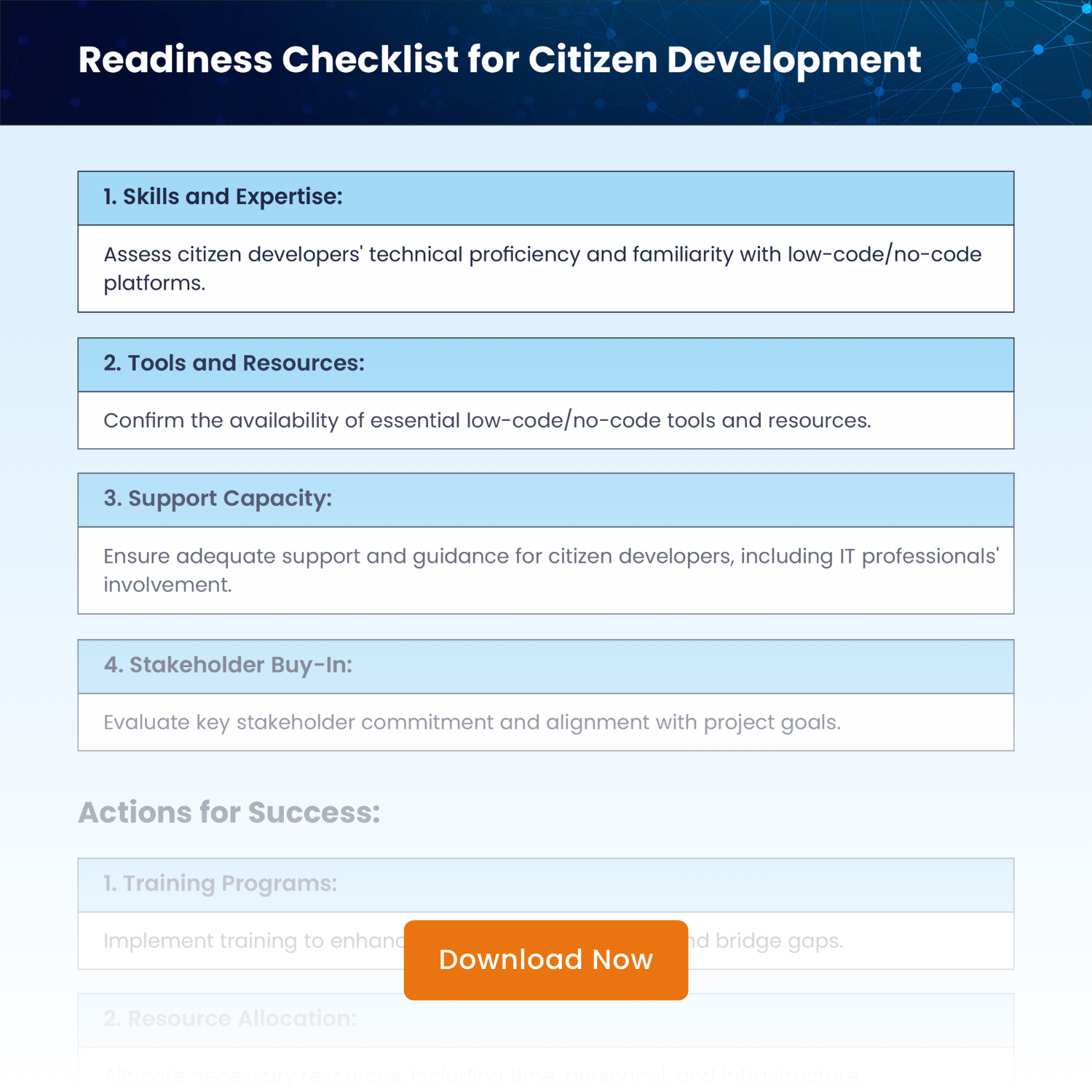
The Domino Effect: Project Risks Arising from Strategy Misalignment
Embarking on citizen development projects presents an avenue for organizational innovation and agility. However, these ventures are not immune to risks that could potentially impede their success. Understanding the potential impacts of these risks is essential to navigate and mitigate challenges effectively.
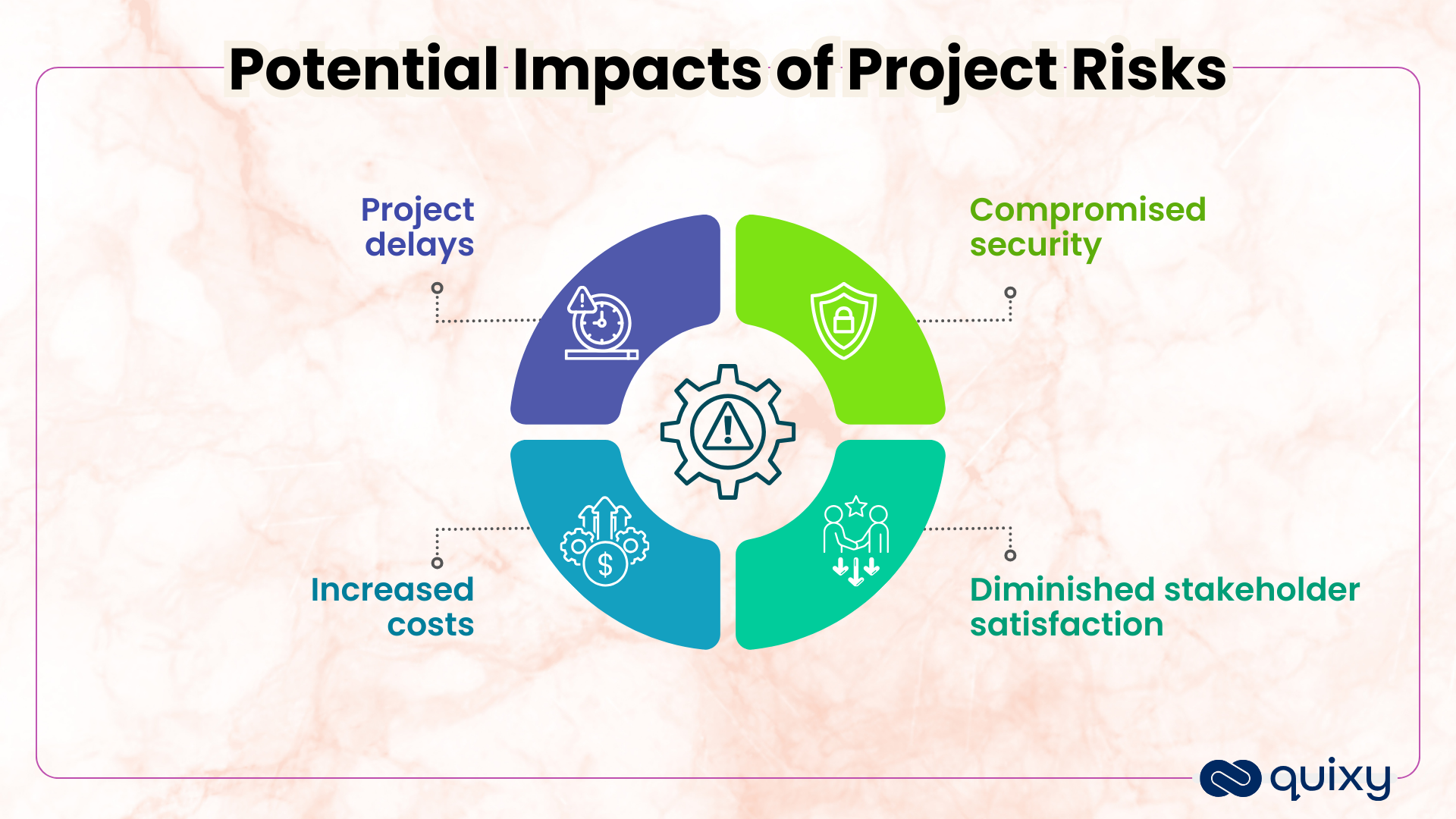
- Project Delays:
- Hindered project timelines, leading to delays in delivering intended solutions or applications.
- Increased Costs:
- Escalated project expenses surpassing the initially allocated budget due to unforeseen issues.
- Compromised Security:
- Vulnerabilities in developed applications or systems, risking potential data breaches or unauthorized access.
- Diminished Stakeholder Satisfaction:
- Reduced satisfaction among stakeholders, stemming from solutions not meeting their needs or expectations.
These impacts underscore the importance of proactive risk management strategies to safeguard against adverse effects and ensure the smooth execution of citizen development projects.
Identifying and Tracking Project Risks
Let’s dive into the landscape of common project risks and their potential impacts on your citizen development project. Identifying and comprehending these risks is a pivotal step in effective risk management.
Imagine navigating a ship through uncharted waters. Understanding the potential hazards ahead allows us to steer clear of troubled waters and ensures a smoother voyage toward project success.
Engaging Stakeholders in Risk Identification and Mitigation
Engaging stakeholders actively in risk management processes is crucial. We’ll explore methods to involve them effectively in identifying and addressing potential risks. By leveraging their insights and expertise, we enhance our ability to foresee and mitigate risks more comprehensively.
Stakeholders are valuable partners in risk mitigation efforts. We’ll discuss collaborative approaches to develop effective risk mitigation strategies. By pooling diverse perspectives and resources, stakeholders become active participants in mitigating risks, contributing to the project’s success.
We offer a comprehensive resource to streamline the assessment phase, enabling a thorough and efficient evaluation of potential risks. By leveraging the Citizen Development risk mitigation scorecard, you can access detailed insights and a systematic approach that empowers you to identify, categorize, and prioritize risks more easily. This facilitates a more robust risk assessment process, allowing for informed decision-making and proactive risk mitigation strategies to safeguard your project’s success.
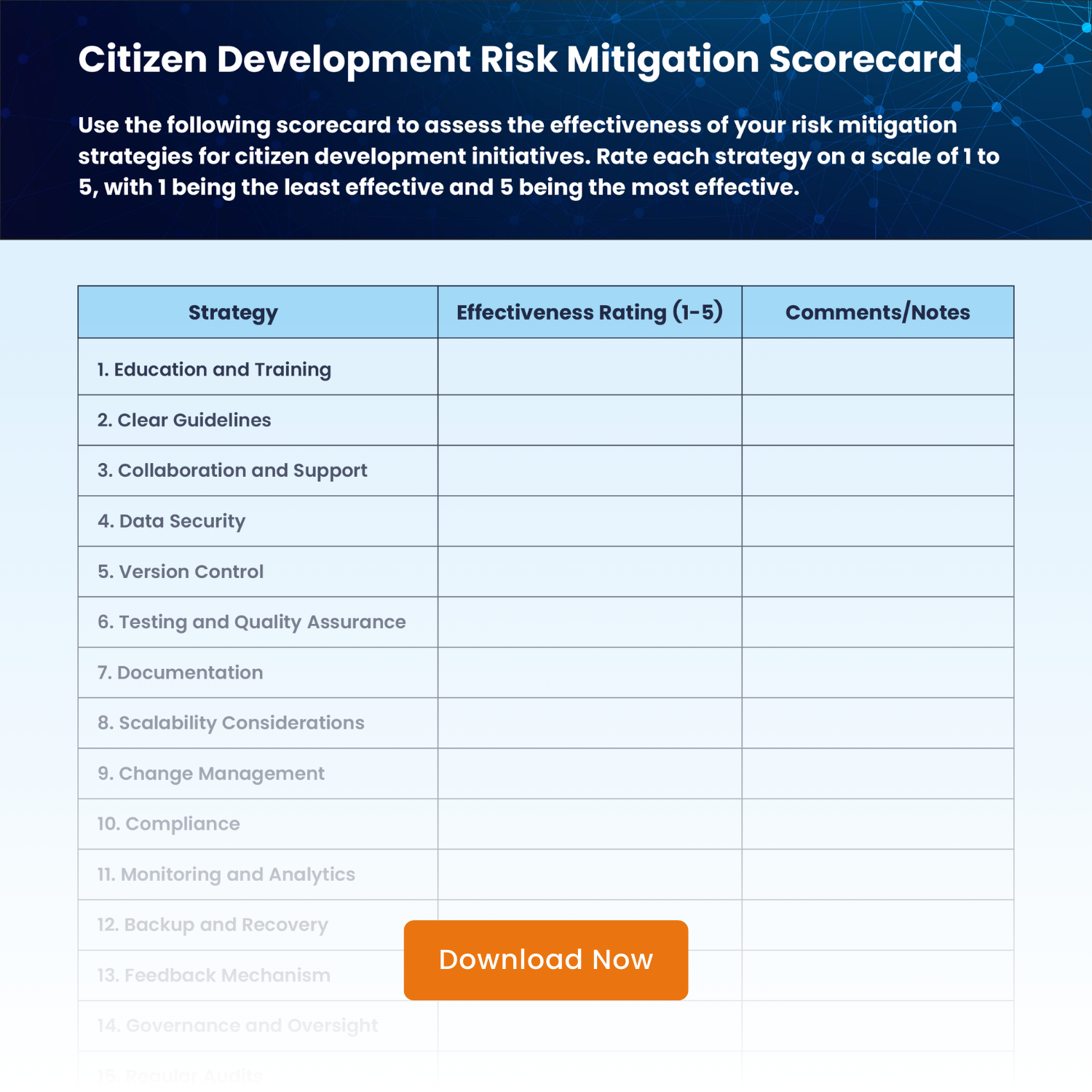
Establishing Effective Communication Channels for Risk Awareness
Also, Transparent and effective communication is the backbone of risk mitigation. Discover how to establish clear and accessible communication channels to ensure stakeholders are well-informed about project risks. Open communication fosters a shared understanding of risks, empowering stakeholders to act proactively.
Also Read: How to Implement and Govern Citizen Development
Communication Management Plan for Risk Awareness
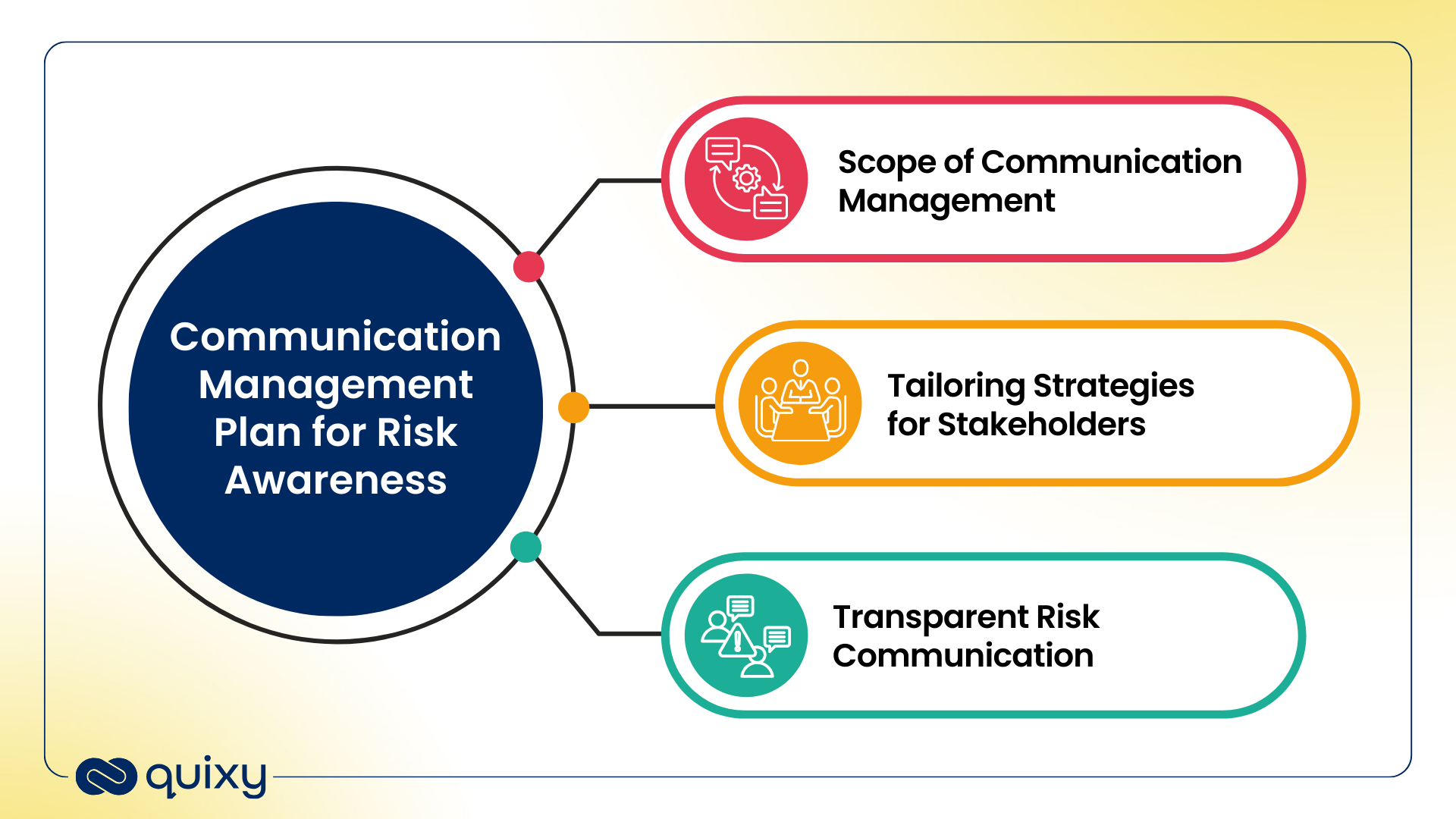
Defining the Scope and Purpose of Communication Management
Communication management isn’t just about talking; it’s about ensuring everyone understands the risks. We’ll define its scope and purpose in conveying risk-related information effectively to stakeholders.
Tailoring Communication Strategies for Different Stakeholder Groups
Each stakeholder group has unique information needs. Discover how to tailor your communication strategies to meet the preferences and requirements of diverse stakeholder groups. By delivering tailored messages, we ensure that information resonates effectively.
Ensuring Transparent Communication on Project Risks
Transparency breeds trust. We’ll discuss methods to ensure that your communication about project risks remains transparent, conveying essential information to all stakeholders. Transparent communication builds confidence and facilitates informed decision-making.
Also Read: Top Resources on Citizen Development
Conclusion
The chorus of success sings through synchronized stakeholder engagement, vigilant risk navigation, and the spotlight on immaculate project requirements in the colorful canvas of citizen development.
We’ve learned that successful citizen development relies on managing risks and understanding project requirements. We’ve explored how identifying and tackling risks early on and meeting stakeholder needs are crucial for success.
By knowing the potential impacts of risks and involving stakeholders, we’ve seen how to handle challenges better. Tools like the Citizen Development Readiness Checklist prepare us, while clear communication and meeting stakeholder needs guide us.
To succeed in citizen development, we must anticipate risks, communicate effectively, and meet stakeholder needs. Armed with these insights, you’re now better equipped for a successful journey in citizen development.
Frequently Asked Questions (FAQs)
Q. What are Common risks in citizen development projects?
Risks include scope creep (expanding the project beyond initial plans), integration challenges with existing systems, potential security vulnerabilities in apps, and inadequate stakeholder engagement impacting project direction.
Q. What are the Stakeholders’ role in risk mitigation?
Stakeholders contribute by identifying potential risks, sharing insights for risk management strategies, and actively participating in risk mitigation plans, leveraging their expertise to ensure better risk anticipation and resolution.
Q. Why are clear project requirements vital?
Clear requirements bridge communication gaps between stakeholders and developers, reducing misinterpretations. They ensure alignment, minimizing errors, rework, and enhancing project efficiency by providing a defined roadmap for development.
Q. What are the Benefits of proactive risk management?
Proactive risk management anticipates potential issues, mitigates their impact, and ensures timely resolution, reducing project disruptions and costs. Clear requirements complement risk management by enhancing predictability, minimizing surprises, and fostering smoother project execution.
Q. What are the consequences of neglecting risk management?
Neglecting risk management can result in various consequences detrimental to projects. These consequences include unexpected issues arising during the project, increased likelihood of project failure, cost overruns due to unanticipated problems, missed deadlines, damaged stakeholder trust, and diminished project quality. Overall, the absence of risk management may lead to chaotic project execution, affecting timelines, budgets, and the project’s ultimate success.
Subscribe
Login
Please login to comment
0 Comments
Oldest















